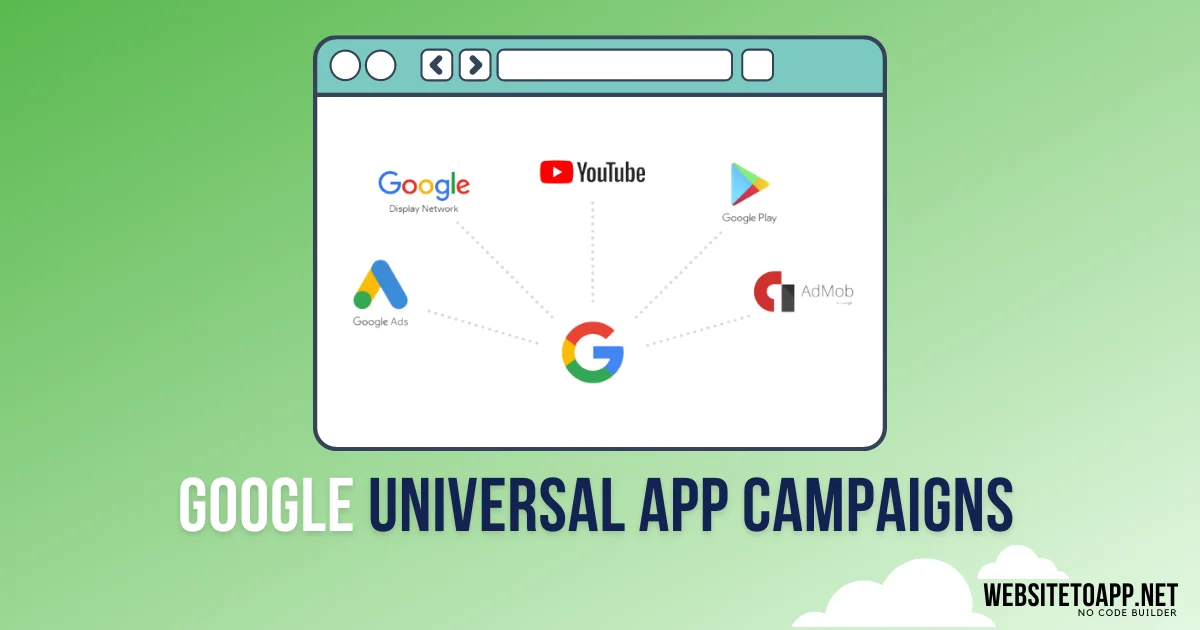Google UAC, or Universal App Campaigns, is a type of automated ad campaign that can help businesses promote their mobile apps to a wider audience. UAC is designed to simplify the advertising process by providing easy access to Google’s network of properties, allowing businesses to drive users to both the Google Play Store and Apple App Store.

UAC uses machine learning to identify the best-performing ads and show them to the most relevant users, which can help businesses generate more app installs and drive in-app conversions. With UAC, businesses can run ads across multiple Google properties, including Google Search, YouTube, Google Play, and within other apps on the Display Network.
Overall, UAC is a powerful tool for businesses looking to promote their mobile apps and drive user engagement. By leveraging Google’s network of properties and machine learning capabilities, businesses can reach a wider audience and drive more installs and conversions for their apps.
Overview of Google UAC

Google UAC stands for Google Universal App Campaign. It is a powerful advertising tool that is used by many in the mobile marketing industry to drive app installs and revenues. The platform is part of Google Ads, and it provides easy advertising access to Google’s network of properties with the flexibility of driving users to both the Google Play Store and Apple App Store.
Google UAC is designed to help mobile app developers and marketers promote their apps across Google’s various platforms, including Google Search, Google Play, YouTube, and the Google Display Network. The platform uses machine learning and automation to help advertisers create and optimize their campaigns, making it easier to reach the right audience with the right message.
One of the key advantages of Google UAC is that it allows marketers to target users based on their interests, behaviors, and demographics. This means that advertisers can create highly targeted campaigns that are more likely to reach users who are interested in their app. Additionally, Google UAC provides detailed analytics and reporting tools, allowing marketers to track the performance of their campaigns and make data-driven decisions.
Overall, Google UAC is an essential tool for any mobile app developer or marketer looking to promote their app and drive installs and revenues. With its powerful targeting capabilities, automation, and detailed reporting tools, Google UAC makes it easier than ever to reach the right audience and achieve your app marketing goals.
Setting Up a Google UAC Campaign

Setting up a Google UAC campaign is a simple process, and it can be done in a few steps. Here are the key steps that you need to follow:
Account Creation
Before you can set up a Google UAC campaign, you need to create a Google Ads account. To create an account, you need to provide your business details, billing information, and payment information. Once you have created an account, you can start setting up your campaign.
Campaign Objectives
The first step in setting up a Google UAC campaign is to determine your campaign objectives. You need to decide what you want to achieve with your campaign, whether it’s to drive app installs, in-app actions, or both. You can choose from a range of campaign objectives, including installs, in-app actions, and value-based bidding.
Budget Allocation
The next step is to allocate your budget. You need to decide how much you want to spend on your campaign and how you want to allocate your budget. You can choose from a range of bidding options, including cost per install (CPI), cost per action (CPA), and target return on ad spend (ROAS).
Once you have determined your campaign objectives and budget, you can start creating your campaign. You can choose from a range of ad formats, including text, image, and video ads. You can also choose from a range of targeting options, including demographics, interests, and behaviors.
In summary, setting up a Google UAC campaign is a simple process that can be done in a few steps. You need to create a Google Ads account, determine your campaign objectives, and allocate your budget. By following these steps, you can create a successful Google UAC campaign that helps you achieve your business goals.
Key Features of Google UAC

Machine Learning
One of the key features of Google UAC is its use of machine learning. Google UAC leverages machine learning to optimize ad placements, targeting, and bidding, streamlining the process for advertisers. This means that the system is capable of automatically adjusting bids and targeting based on performance data, which can help to improve the efficiency and effectiveness of ad campaigns.
Ad Asset Variations
Another important feature of Google UAC is its ability to generate ad asset variations. With Google UAC, advertisers can create a single ad campaign that can be used across multiple platforms, including Google Play, YouTube, and the Display Network. The system is capable of generating a variety of ad asset variations, including text, image, and video ads, which can help to improve the effectiveness of campaigns by reaching a wider audience.
Performance Optimization
Google UAC also offers a range of performance optimization features. These include the ability to set campaign goals and budgets, as well as the ability to track key performance metrics such as installs, clicks, and conversions. Advertisers can use this data to optimize their campaigns and improve their return on investment (ROI).
In summary, Google UAC is a powerful advertising tool that offers a range of features designed to help advertisers promote their mobile apps. Its use of machine learning, ad asset variations, and performance optimization make it an effective tool for reaching a wider audience and improving campaign efficiency.
Targeting Options in Google UAC

Google UAC offers a wide range of targeting options to help advertisers reach the right audience. Here are some of the most important targeting options available in Google UAC:
Audience Targeting
One of the most powerful features of Google UAC is its audience targeting capabilities. Advertisers can target their ads based on a variety of factors, including demographics, interests, behaviors, and more. This allows them to reach users who are most likely to be interested in their app.
Location Targeting
Location targeting is another important feature of Google UAC. Advertisers can target their ads based on a user’s location, whether that’s a specific city, state, or country. This is particularly useful for apps that are only available in certain regions, or for advertisers who want to target users in specific locations.
Device Targeting
Device targeting allows advertisers to target their ads based on the type of device a user is using. This includes targeting specific operating systems (such as iOS or Android), as well as specific device types (such as smartphones or tablets). This allows advertisers to tailor their ads to the specific needs and preferences of their target audience.
Overall, Google UAC offers a wide range of targeting options that can help advertisers reach the right audience and achieve their campaign goals. By using these targeting options effectively, advertisers can maximize the impact of their ads and drive more app installs and conversions.
Ad Formats and Creatives

Google UAC offers three types of ad formats: text ads, image ads, and video ads. Each ad format has its own unique set of requirements and best practices to follow.
Text Ads
Text ads are the simplest type of ad format offered by Google UAC. They consist of a headline and two lines of text. The headline should be no more than 30 characters long, while each line of text should be no more than 90 characters long. Text ads are a great way to convey a short and sweet message to potential users.
Image Ads
Image ads are a more visually appealing type of ad format offered by Google UAC. They consist of an image and a headline. The image should be eye-catching and relevant to the app being advertised. The headline should be no more than 30 characters long. Image ads are a great way to showcase the app being advertised and grab the user’s attention.
Video Ads
Video ads are the most engaging type of ad format offered by Google UAC. They consist of a video and a headline. The video should be no more than 30 seconds long and should be relevant to the app being advertised. The headline should be no more than 30 characters long. Video ads are a great way to showcase the app being advertised and provide users with a more immersive experience.
Overall, it’s important to choose the ad format that best suits the app being advertised and the target audience. By following Google UAC’s guidelines and best practices, app marketers can create effective ad campaigns that drive installs and in-app conversions.
Measuring Success in Google UAC
When running a Google UAC campaign, measuring success is crucial to ensure that the campaign is achieving the desired results. There are several key performance indicators (KPIs) that advertisers should track to assess the effectiveness of their UAC campaigns.
Key Performance Indicators
The following are some of the most important KPIs to track when measuring the success of a UAC campaign:
- Installs: The number of app installs resulting from the UAC campaign.
- Cost per install (CPI): The average cost of each app install.
- Click-through rate (CTR): The percentage of users who click on the ad after seeing it.
- Conversion rate (CR): The percentage of users who complete a desired action, such as making a purchase or signing up for a service, after clicking on the ad.
By monitoring these KPIs, advertisers can gain insights into the performance of their UAC campaigns and make data-driven optimizations to improve results.
Conversion Tracking
To accurately measure KPIs such as installs and conversions, it is essential to set up conversion tracking. Conversion tracking allows advertisers to track user actions within their app, such as purchases or sign-ups, and attribute them to specific ads or campaigns.
Google Ads provides several options for conversion tracking, including in-app events, Firebase, and third-party integrations. By setting up conversion tracking, advertisers can gain a deeper understanding of the impact of their UAC campaigns and optimize their ad targeting and bidding accordingly.
Reporting Tools
Google Ads also provides a variety of reporting tools to help advertisers analyze the performance of their UAC campaigns. These tools include:
- Campaign reports: Provides an overview of campaign performance, including metrics such as impressions, clicks, and conversions.
- Ad group reports: Provides more granular data on ad group performance, including metrics such as cost per click (CPC) and conversion rate.
- Placement reports: Provides insights into where ads are being displayed and how they are performing on specific placements, such as the Google Play Store or YouTube.
By using these reporting tools, advertisers can identify areas for improvement and make informed decisions about how to optimize their UAC campaigns for better results.
Best Practices for Google UAC
Google UAC is an effective way to promote apps across different platforms within a unified system. Here are some best practices for creating successful Google UAC campaigns.
Ad Content Strategy
When creating ad content for Google UAC, it is important to keep in mind the following best practices:
- Use clear and concise language to describe the app’s features and benefits.
- Use high-quality images and videos that accurately represent the app.
- Use a clear call-to-action that encourages users to download the app.
- Use different ad formats to reach a wider audience.
Bid Strategies
Bid strategies are an important part of Google UAC. Here are some best practices for bid strategies:
- Use automated bidding to optimize performance and maximize conversions.
- Set a target cost-per-install (CPI) that is aligned with the app’s revenue goals.
- Adjust bids based on performance data to improve ROI.
Testing and Iteration
Testing and iteration are crucial for creating successful Google UAC campaigns. Here are some best practices for testing and iteration:
- Test different ad formats, ad content, and bidding strategies to find the best combination.
- Use A/B testing to compare the performance of different ad variations.
- Use performance data to make informed decisions about ad content and bidding strategies.
By following these best practices, advertisers can create effective Google UAC campaigns that drive app installs and in-app conversions.
Challenges and Considerations
Competition Analysis
One of the challenges of running a Google UAC campaign is the level of competition in the app market. There are millions of apps in the app stores, and it can be difficult to stand out from the crowd. Therefore, conducting a thorough competition analysis is crucial to ensure that the app is targeting the right audience and standing out from the competition.
Ad Fatigue
Another consideration when running a Google UAC campaign is ad fatigue. Users may become tired of seeing the same ad repeatedly, leading to a decrease in click-through rates and conversions. To combat ad fatigue, it is important to continuously refresh ad creatives and test different ad formats and messaging.
Privacy Regulations
Privacy regulations, such as GDPR and CCPA, also pose a challenge for Google UAC campaigns. Advertisers must ensure that they are collecting and using user data in compliance with these regulations. This includes obtaining proper consent from users and providing transparency about data collection and usage.
Overall, running a successful Google UAC campaign requires careful consideration of these challenges and a strategic approach to overcome them. By conducting a thorough competition analysis, combating ad fatigue, and complying with privacy regulations, advertisers can increase the effectiveness of their Google UAC campaigns.
